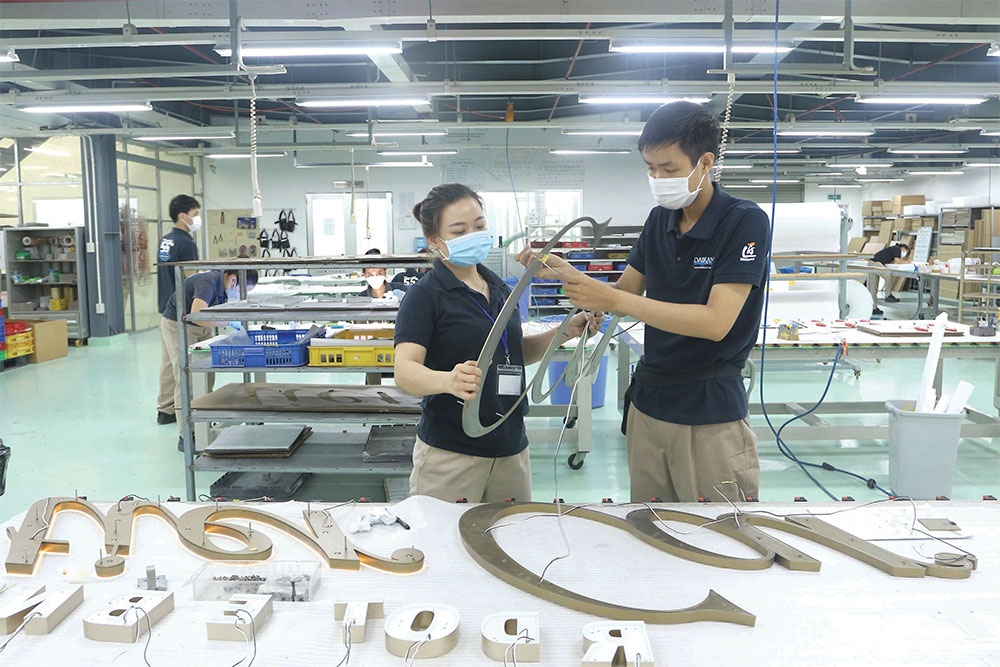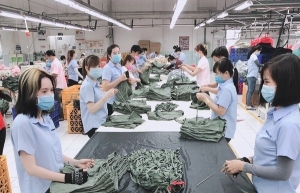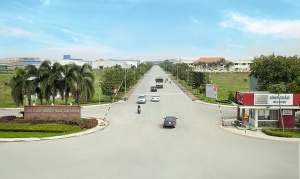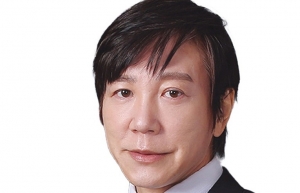Diversification still on radar of major foreign investors
 |
| Massive tech groups are pumping more money into Vietnam, contributing to the nation’s FDI targets, Le Toan |
Last week, Edmund Malesky, director at Duke University’s Center for International Development in the United States, said he appreciated the role of foreign direct investment (FDI) in Vietnam’s stellar economic performance in 2022.
“The country concluded the year as the best-performing economy in Asia, largely due to its ability to attract foreign funding relocating from China,” Malesky said.
A few days ago, laptop manufacturer Quanta Computer revealed its intention to set up a factory in the north of Vietnam to fulfil orders for Apple MacBooks, according to DigiTimes.
Based in Taiwan, Quanta is a component manufacturer for many major computer brands worldwide, such as Dell, Toshiba, Amazon, HP, Cisco, Lenovo, and Fujitsu. It is also the largest Apple Watch manufacturing partner.
Previously, Apple said it planned to move some MacBook production lines to Vietnam for the first time to diversify production outside China. Apple has asked Foxconn to start manufacturing MacBooks in Vietnam as soon as possible, believed to be in Q2 of this year.
“After changing the production of MacBooks, all of Apple’s flagship products will basically have one more production location outside of China – iPhone in India and MacBook, Apple Watch, and iPad in Vietnam,” a source told Nikkei Asia.
Apple has been preparing for two years to move dozens of its facilities or Taiwanese suppliers to Vietnam and set up a trial production line here.
Also last year, Danish toymaker Lego Group started constructing a $1 billion plant in the southern province of Binh Duong that will include cutting-edge environmental standards to achieve carbon-neutral emissions.
However, due to the drop in the number of billion-dollar projects, registered inflows in 2022 were down 11 per cent on-year. The total newly registered capital, adjusted capital, capital contributions, and share purchases stood at $27.7 billion for the year, according to the Ministry of Planning and Investment’s Foreign Investment Agency (FIA). FIA director general Do Nhat Hoang underlined some factors behind the falling registered capital.
“Strict pandemic preventive measures had made it more difficult for foreign investors to travel to Vietnam. Such hindrance held back the number of newly registered projects early in 2022,” said Hoang. “Global uncertainties including geopolitical conflicts, inflationary pressures, and supply chain disruptions also compounded the situation by scaling down capital flows from big economies, especially Vietnam’s partners.”
Over the year, over 2,000 projects were granted investment registration certificates, with the total registered capital of almost $12.5 billion, down 18.4 per cent from last year. There were around 3,560 capital contributions and share purchases as of December 20, equivalent to $5.2 billion and a dip of 25.2 per cent over 2021.
On the bright side, many large-scale projects had their capital adjusted up significantly in 2022. For instance, Samsung Electro-Mechanics Vietnam was given two capital boosts, of $920 million and $267 million. Samsung HCMC CE followed suit with $841 million. Programmes to manufacture electronics and multimedia devices in Bac Ninh and Nghe An provinces, and Haiphong city were financed with additional capital of $306 million, $260 million, and $127 million, respectively. The adjusted capital reached over $10.1 billion, up 12.2 per cent on-year.
Explaining the increase in additional capital, Malesky said that investor interest in Vietnam had grown steadily over time and further accelerated in 2018 when US tariffs raised the costs of doing business in China.
“Many companies had already been producing most of their goods in China while maintaining and expanding facilities in Vietnam as a hedge against uncertainty. Due to the US tariffs, these companies executed these insurance contracts and shifted production to Vietnam,” he said.
More recently, foundations have been laid for Vietnam to speed up and reach the goals outlined in 2023 that call for $36-38 billion of FDI into the country. Numerous large corporations and well-known names have pledged to invest and expand their facilities in Vietnam.
Belgium’s CMA-CGM plans to extend Gemalink Port phase 2 in Haiphong’s Cai Mep and Lach Huyen seaports. Dutch husbandry company De Heus, which has already poured $1 billion into Vietnam, is considering strengthening cooperation with local partners and expanding its production scale. Also, corporations such as Nedspice, Harvest Waste, Heineken, and B-Medical Systems have indicated they will make new moves in this country soon.
During State President Nguyen Xuan Phuc’s visit to South Korea last year, 24 cooperation agreements were signed, and about $15 billion was committed to Vietnam. Samsung Electronics has raised its total investment in Vietnam to $20 billion, focusing on AI and big data; LG will spend $4 billion additionally in Vietnam; and Hyosung will level up funding to $5 billion, up from $3.5 billion.
Similar commitments have been given by Hyundai, Daewoo E&C, Lotte Group, and others that could enable Vietnam to be a new global manufacturing hub.
In the south, Thailand’s SCG is considering expanding the second phase of its Southern Petrochemical Complex with a total investment of $5.5 billion, while Earth Vision would like to produce industrial wood for the construction industry with additional funding of $1.3 billion.
“Based on these commitments and plans, Vietnam could reach its 2023 goals, along with the continuous soaring of FDI disbursement. We expect that inflows would be a good foundation for Vietnam’s growth and socioeconomic development in the new year,” Hoang said.
| Do Van Su-Deputy director general Foreign Investment Agency Despite the result of mobilising FDI into Vietnam last year not being very high as expected, we are still happy with some successes. The disbursement of FDI reached $22.4 billion, a rise of 13.5 per cent on-year. This is not the highest amount ever, but a good signal confirming the recovery and expansion of foreign-invested enterprises after the pandemic. This is the first time that the gap between registered and disbursed capital has been so close. In previous years, disbursed FDI used to equal 60-70 per cent of the registered figure. Especially, in 2022 it was hard to mobilise FDI, which was the common situation worldwide, and developed countries’ outward investment trend reported some decreases. Investor uncertainty and risk exposure due to the impact of global political conflicts, rising inflationary pressures, and supply chain disruptions put significant downward pressure on global FDI in 2022, and investment capital flows abroad in major economies, especially investment partners of Vietnam. The United Nations Conference on Trade and Development forecast that global investment would go down or flatten last year. We were too worried about the drop in FDI inflows, especially in newly-registered, but it got better in the second half of last year. The decrease on-year has gotten smaller month by month, and the number of newly-registered FDI projects soared sharply to just over 2,000, an increase of 17.1 per cent on-year. So the drop in newly-registered FDI in 2022 was caused by the lack of large-sized projects (like in previous years), which often take 5-7 years to look for, consider, and negotiate before the final steps. We were stuck for two years of the pandemic, so it was certain that we would have fewer large-sized projects than in previous years. In the new year, we can expect some new big projects from South Korean investors deciding to invest in Vietnam very soon. Besides that, we can set eyes on the fluctuations of the European energy market and the investment trends of European investors that are withdrawing from Ukraine. Additionally, when China opens, supply chains will resume, and capital flows will change and affect FDI inflows in Vietnam. We lay some positive expectations on FDI in the new year. |
 | China’s FDI inflows to Vietnam to increase: Agriseco Foreign direct investment (FDI) inflow from China to Vietnam is expected to rise as China is to reopen its doors and resume flights between the two countries, according to Agribank Securities Company (Agriseco). |
 | New FDI challenges for southeast The southeast continues to take the lead in attracting overseas investment despite the increasing problem of land availability. |
 | Japanese investors keeping eye on fresh 2023 trends Last year was a complex one for Japanese businesses operating in Vietnam. After a turbulent 2021, we expected 2022 would accelerate Vietnam's recovery path. However, things have not been easy with the pandemic earlier in the year, the Ukraine conflict beginning, increased energy and logistics costs, and Chinese restrictions. |
What the stars mean:
★ Poor ★ ★ Promising ★★★ Good ★★★★ Very good ★★★★★ Exceptional
Related Contents
Latest News
More News
- Global partnerships key to Vietnam’s IFC development (December 26, 2025 | 16:18)
- Vingroup pulls out of bid to invest in North-South high-speed railway (December 26, 2025 | 11:42)
- Strengthening supply chains through trade promotions and customs reform (December 24, 2025 | 14:00)
- PM orders investment model for North–South high-speed rail (December 22, 2025 | 17:43)
- LS Eco Energy to invest in Vietnam rare earth sector (December 22, 2025 | 17:31)
- Government moves to establish International Financial Centre (December 21, 2025 | 21:00)
- Vietnam's IFC to target global investment flows (December 21, 2025 | 18:00)
- Two national hospitals expand capacity with new facilities (December 20, 2025 | 09:00)
- Ha Tinh breaks ground on major Vingroup industrial and energy projects (December 19, 2025 | 18:24)
- EVN launches major power infrastructure projects nationwide (December 19, 2025 | 18:17)

 Tag:
Tag:




















 Mobile Version
Mobile Version